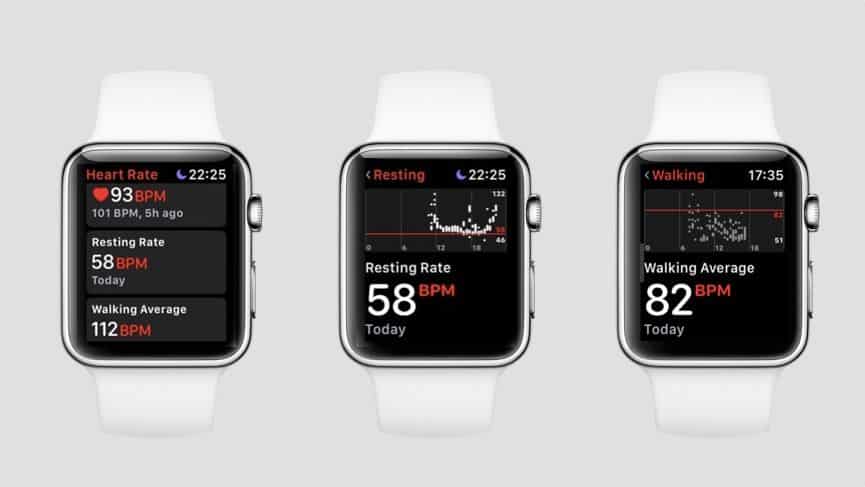Apple Watches let you track your heart’s performance
Over recent years, the Apple Watch has become a popular heart rate monitor. However, new Series 4 and WatchOS 5 have made it even more popular. Previous models of Apple Watch feature basic heart health programs, giving wearers a high heart rate notification and resting heart rate stats. The Apple Watch Series 4 now provides medical-grade accuracy through high-level Electrocardiogram (ECG) monitoring.
Now your Apple watch will go beyond simply providing you with basic information about your heart’s activity, such as your workout stats and active minutes. The whole new heart rate monitor will provide atrial fibrillation detection, details on heart rate rhythm and low heart rate detection.
How does the Apple Watch heart rate monitor work?
Every watch featuring a heart rate monitor uses the same technology, including the Apple Watch. These watches work based on photoplethysmosgraphy. Our blood is red, as it reflects red light and absorbs green light. A heart-rate monitoring device uses a green light emitting diode (LED) with photodiodes to find the amount of blood flowing through your wrist. While the heart beats, this flow and therefore the amount of green light being absorbed is greater. To attain the most accurate beats per minute (BPM) data, LEDs flash hundreds of times per second.
Apple Watches let you track your heart’s activity. Source
ECG measures the heart’s electrical activity with a 12-lead test, using different kinds of electrodes and wires and monitored by a medical professional. Apple watch runs the basic version of this process, with a device that users can wear all day for a few hundred dollars.
Apple Watch’s ECG forms a circuit that runs from the back of the watch through to its crown. The associated app uses the electrical pulses running through this circuit to get the heart rate. It also checks if the lower or upper chambers of the heart are in rhythm.
Before Apple, many other companies also launched over-the-counter ECG readers. For instance, AliveCor, which is a medical-device startup in Silicon Valley, introduced two FDA-licensed consumer ECG devices: $100 KardiaMobile and $199 Apple Watch band – KardiaBand.
Heart rate monitoring watches are important because around 6.1 million people in America suffer from heart diseases. Research suggests that another 700,000 people in the U.S.A. have irregular heartbeats but remain undiagnosed. Currently, even those with the best access to care receive only 2-3 ECGs a year. Preventative heart screening through these watches can save thousands of lives.
Real-time heart rate
While wearing the Apple Watch, you will get continuous heart rate readings during the workout. You’ll also view the average heart rate during the entire workout after finishing it. However, to see your heart rate while doing other tasks, go to the Watch’s Heart Rate app to get insights into your walking, resting, and overall rate throughout the day.
Resting heart rate
Resting heart rate a good overall measurement of your health and tracking it allows the user to see if their health is improving. On the other hand, spikes in resting heart rate can indicate stress or exhaustion. The Apple Watch can calculate both metrics by correlating readings taken with accelerometer data. A mini-graph will show you how your resting heart rate has changed throughout the day.
Receive heart rate data on your iPhone
The Apple Watch data can also be expanded on the iPhone. To view your heart data from finished workouts, go to the Activity app for a more detailed graph of your heart rate fluctuations. The app allows the user to see how the heart recovered back to normal heart rate a few minutes after finishing a workout session. You will also be able to have a deeper look at your resting rate, walking average and overall heart rate on your iPhone.
Apple Watch prevents people from having heart attacks
Stanford recently showed the results of an Apple Watch-based heart study. It showed that just 0.5 percent of over 400,000 volunteers had irregular heart rhythms. Later, physicians verified that 84 percent of these warnings were atrial fibrillation episodes and, so potential signs of trouble. In other words, the technology avoided most false positives and was reliable for a follow-up with doctors.
Thirty-four of those who received notifications and wore an ECG patch for a week showed irregularities, but that was hoped with intermittent atrial fibrillation. Nearly 57 percent of who received warnings visited their doctor.
While the discussion around heart rate monitors normally focuses on exercise, the potential health applications of the technology could literally save lives. Apple Watch is not the only device to offer heart monitoring features, but leads the rest in how the results from the heart monitoring can be applied to generate useful information about heart health. We’re a long way from replacing traditional ECG machines, but for a portable, relatively inexpensive device that provides continuous monitoring, this technology is exciting for any person who has concerns about the health of their heart.

